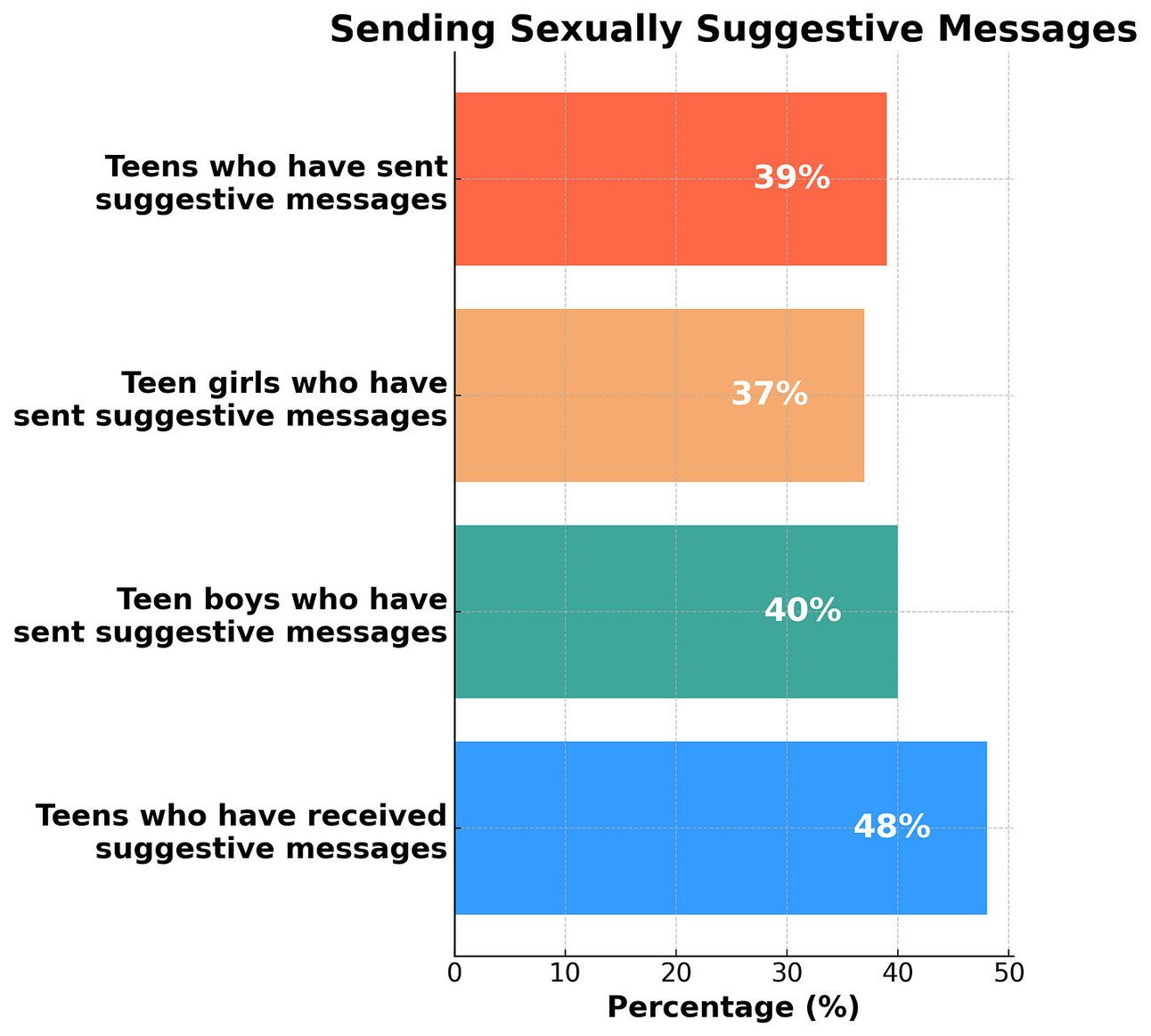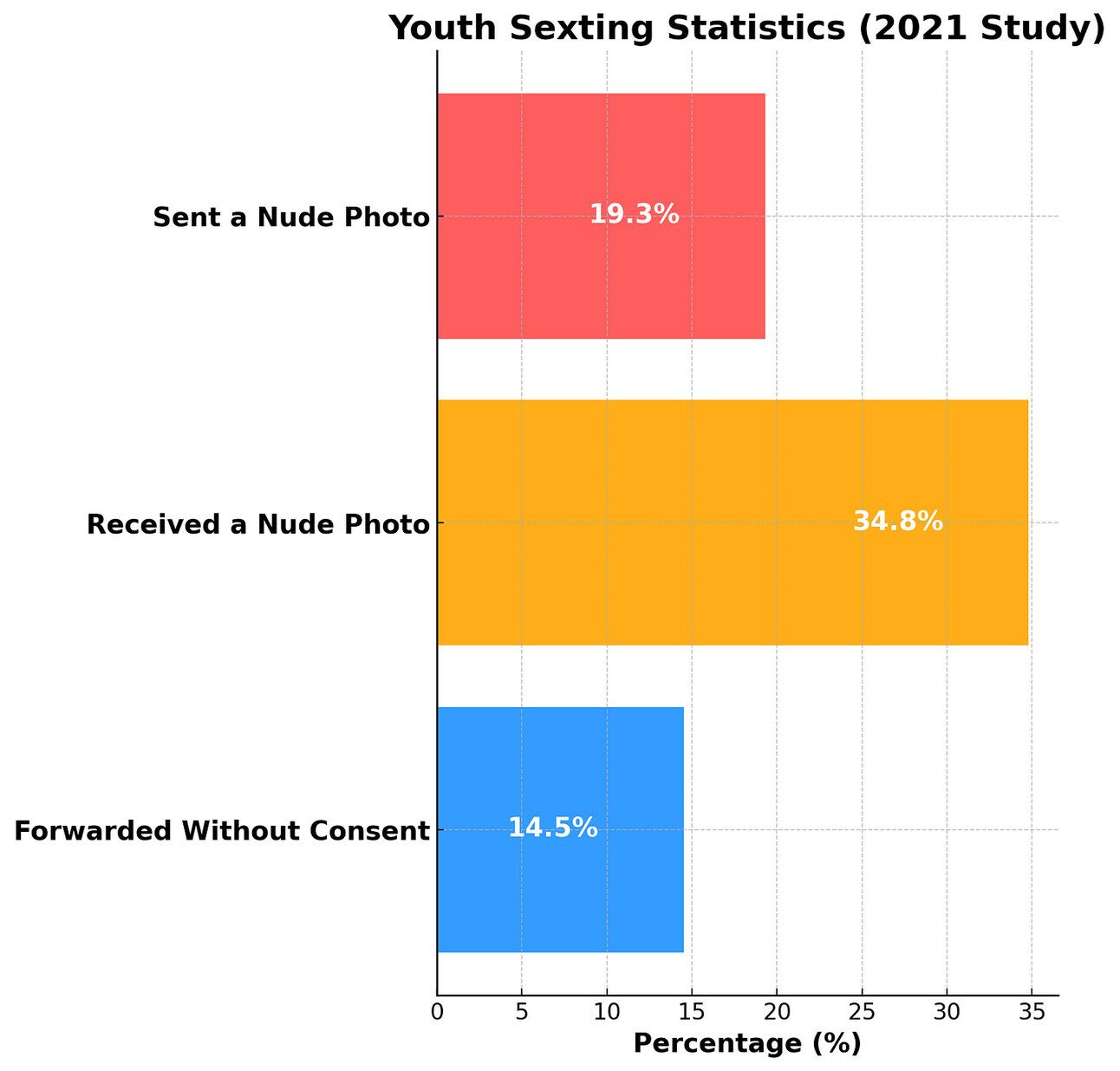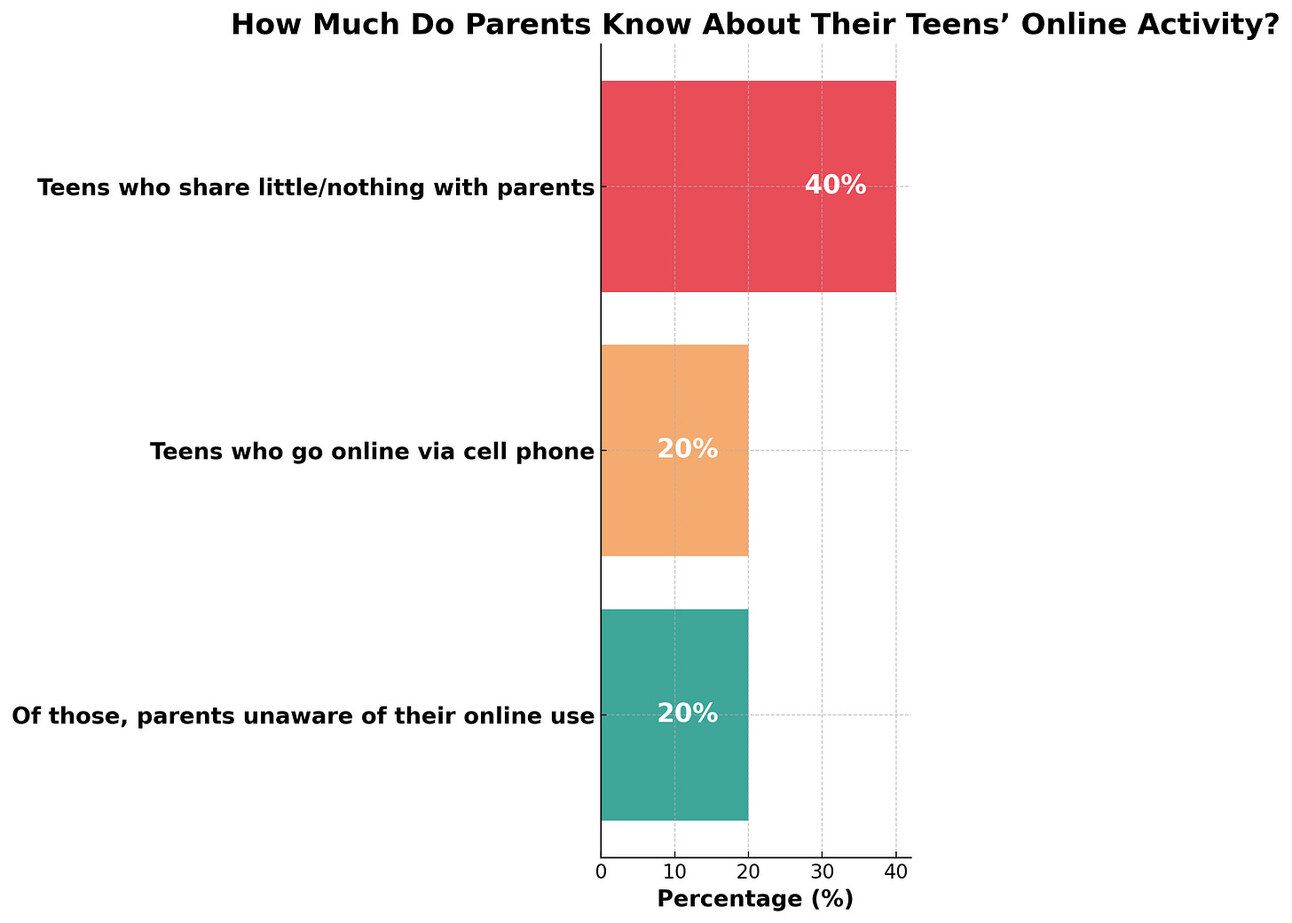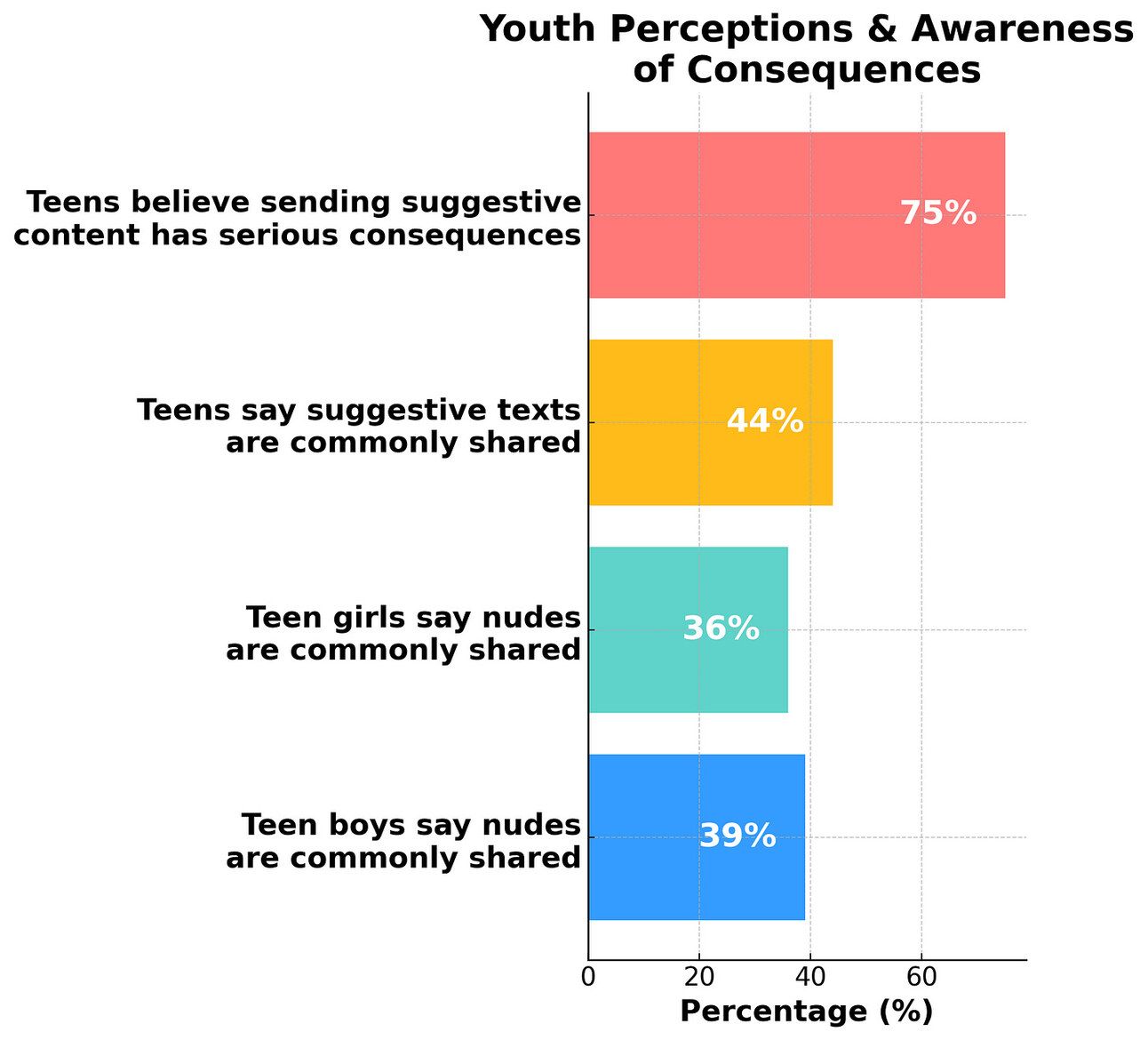- Successful Parent
- Posts
- "Not My Kid" Is a Fantasy: Preteens & Teens Are Sexting
"Not My Kid" Is a Fantasy: Preteens & Teens Are Sexting
"Not my kid."
This is the phrase I hear most often from parents when discussing teen sexting—right before they discover their child is indeed sending or receiving nude photos and videos.
As a psychologist who has worked with teens for over two decades, I've witnessed the aftermath of these private moments becoming public disasters that destroy a young person's sense of self and emotional well-being.
Think your child is immune?
Consider this: middle schoolers now report sexting as a common practice among their peers, with some children as young as 11 participating. When asked what percentage of girls have received unsolicited nude photos from boys, teens answer: "High percentage, more than half."

This isn't happening because our kids are "bad." It's happening because smartphones have transformed adolescence by placing 24/7 connectivity, cameras, and social pressure into hands not yet equipped with the brain structures required for impulse control.
The Hidden Crisis in Your Child's Pocket
The documentary Childhood 2.0 captures what I often saw in my private practice—sweet, intelligent, high-achieving teens who never imagined they would send explicit photos of themselves until that moment of heightened emotion, peer pressure, and hormonal influence.
When "Good Girls" Make Life-Altering Mistakes
I'll never forget the first time I helped a teen who had sent a nude photo of herself. Kate, as I'll call her, came to my office when she was 14—a stunningly beautiful, straight-A student from a highly educated, affluent family. Kate was a freshman at an all-girls private high school when she found herself in a situation she never thought she would.
Kate had developed feelings for a popular, good-looking sophomore boy at the neighboring all-boys high school. Their relationship existed almost entirely through messages, and Kate was painfully aware that many other girls were interested in him. She was worried he might lose interest and move on to someone else.
Late one night during their texting, he asked her for a naked picture.
Though everything inside her knew it was wrong, her fear of losing his attention took over. In that vulnerable moment, alone in her room with the glow of her iPhone, she made a choice she couldn't take back.
The fallout came quickly; the boy forwarded her pictures to others and then he wanted nothing to do with her. By the time Kate's confused parents brought her to my psychotherapy practice, their once-vibrant daughter had become withdrawn and depressed. They couldn't understand what had happened to their child.
Kate's suffering took heartbreaking forms. She'd tell her mom she was meeting friends but would instead hide behind the her family's beach home and cry for hours. She developed bulimia, which she explained: "I'm trying to get rid of what feels bad inside me."
What happened to Kate wasn't rare. I saw this same story play out with many bright, incredible teenage girls throughout my practice. Some parents never discovered why their daughter had suddenly changed—or found out when the damage was already deep.
This Problem is Everywhere—and Getting Worse
In Childhood 2.0, teenagers speak candidly about how common sexting has become and at increasingly younger ages.
"For many young people, sexting could be considered the new first base," explains one teen in documentary, "Kids call it nudes. We call it sexting."
When asked about how quickly boys request nude photos after starting to talk with a girl, one high school student explains, "You're pretty much lucky if you get about two weeks into talking to them before they ask."
Another teenager in the documentary points to the alarming trend of this behavior moving into younger age groups: "My brother's in middle school... it's happening younger and younger, like sixth and seventh grade."
As a result of sexting, our youth are falling prey to digital dangers like cyberbullying and "sextortion" - a type of blackmail where someone threatens to share nude photos unless the victim sends more images or money or provides "favors."
By the Numbers: The Reality of Teen Sexting

Research confirms what teens are telling us. According to a 2019 JAMA Pediatrics study analyzing data from over 110,000 teens:
1 in 4 teens report receiving sexts
1 in 7 report sending sexts
1 in 10 forward sexts without consent
Even more concerning, a 2021 survey by Common Sense Media found that among middle schoolers specifically:
24% of 12-13 year olds have seen sexting messages
18% report being asked to send nude photos
40% didn't tell an adult when it happened
These aren't just statistics—they're children in our communities facing adult situations without adequate guidance or protection.
The Double Standard Destroying Our Daughters
When boys request and share these images, they're often celebrated. But for girls, the aftermath follows a devastating pattern:
"It's a no-win situation," explains one teen. "If you give it to a boy, then you're a slut, then the girls find out about it, then you're cyber-bullied by the girls. If you don't give it, you get yelled at and called a prude."
Meanwhile, boys who send unsolicited nude photos experience minimal social consequences: "They're more unsolicited. Most of my friends have gotten them. For girls, for the most part, get disgusted by it."
Another teen states it plainly: "Nudes of girls go around to school all the time."
In my practice, I helped many teenagers cope with the emotional toll—anxiety, depression, social isolation, eating disorders, and substance abuse. Their sense of trust and self-worth is profoundly damaged.
What Happens After the Photo Is Sent
One teen described the disturbing reality: "There was like a Dropbox, and it was like girls' nudes, just random people. And there was like a list of all the people that had accessed it, and it was even people that you wouldn't think—really good guys. But some girls had no idea that their pictures were out in the open for everyone."
Another revealed the shocking truth about what happens to these images: "All of these naked pictures and videos guys get from girls they went to high school with. They're in their college dorm. They treat them like trading cards."
A Different Approach to Digital Parenting
As the first generation raising children in this digital world, we must adapt our parenting strategies. Our generation faces challenges that previous generations of parents did not have to encounter. The digital landscape has fundamentally changed childhood. We must change how we parent to protect our children's emotional well-being and mental health.

1. Delay Smartphone Access
Consider postponing smartphones until your child is at least 16 years old.
This isn't about punishment—it's about brain development. The part of the brain that supports impulse control, long-term thinking, and sound decision-making isn't fully integrated until around age 25.
A basic flip phone allows for necessary communication without exposing them to the risks of social media, pornography, and constant connectivity. Think back to your teenage years and the impulsive decisions you made. Now imagine having a camera, video recorder, and 24/7 internet access in your pocket during that time. Personally, I'm grateful this technology wasn't available when I was a teen!
2. Have the Uncomfortable Conversations
Based on what teens report, it's not a matter of IF your child will be asked to send nude photos or see nudes of others, but WHEN. Open this dialogue early and revisit it often. Try saying: "This might feel awkward to talk about with me, but I want you to be prepared for something happening to teens. You might like someone who asks you to send them nude photos. You might feel excited by this attention, and that's completely normal. But those physical feelings can lead to decisions that might hurt you later."
Explain how our bodies get excited and titillated during these moments—this is normal, and it's important not to act impulsively when feeling this way.
3. Role-Play Responses
Practice specific phrases your teen can use when faced with pressure:
"I'm not comfortable with that."
"That's not something I do."
"I respect myself too much to share that."
"If you really like me, you won't ask me to do something that could hurt me."
If you practice and role-play these scenarios, your child will have a framework established in their brain, making it easier to recall during moments of pressure and excitement.
4. Educate About Digital Permanence and Legal Consequences
Help your child understand that nothing digital is truly temporary or private, despite what apps like Snapchat might suggest. As teens in the documentary explain:
"It gets distributed, especially with Snapchat, which was kind of created for that exact purpose. It gives people a sense of 'oh, it's not that serious, the pictures go away.' But we all can realize now that's definitely not true."

Make sure your children understand that:
Texts, photos, and videos on the internet can remain there forever.
Sexting involves pictures or videos which may be considered child pornography because they are minors.
Both senders and receivers could be charged and prosecuted depending on state laws.
There can be serious consequences, including police involvement. (This has already happened at schools across our nation)
Teens may be suspended from school and have labels on their permanent record that could hurt their chances of getting into college or finding employment.
5. Create a Safety Plan
Let your child know that they can always come to you for help without shame or punishment if they ever make a mistake in this area. The faster you know about it, the more effectively you can help them.
Many teens suffer in silence because they're horrified at the thought of their parents finding out. This isolation only compounds the psychological damage.
Take Action Today
Don't wait for a crisis to have these conversations. Here's what you can do right now:
Tonight: Ask your child if anyone at their school has ever sent or received nude photos. Tell them they do not need to provide names. Listen without judgment.
This weekend: Practice role-playing responses to pressure situations. "What would you say if someone asked you for a photo?"
Within one week: Replace your child's smartphone with a basic flip-phone if they're under 16, or install monitoring software that alerts you to concerning activity. Check out Bark and Canopy as potential filtering and monitoring systems to alert you to concerning activity.
When I began this article with "'Not my kid' is a fantasy," I wasn't trying to frighten you—rather, I am inviting you to recognize a reality that affects families regardless of income, education, or values. The parents who brought Kate to my office never imagined their daughter would be involved in sexting. They believed in the fantasy, too. But once they faced reality, they could finally help her heal. This happens to great kids from good families.
The difference between parents who can protect their children versus those who can only react to the harmful aftermath isn't about luck—it's about facing this digital reality with compassion and courage. Our children are navigating a digital world we didn't experience at their age. When we shift from "Not my kid" to "This could affect my child too—let's discuss it openly," we build the foundation of trust and the preparation that could really help our children.
This single mindset change can make all the difference in whether your child is armed with practiced responses for that moment this peer pressure comes and whether or not they'll talk to you about this uncomfortable side of their digital world.
For additional resources and support, visit www.successfulparent.com to download your free copy of "A Parent's Guide to Better Tech Boundaries" and join our community of parents committed to raising mentally healthy children in the digital age.
Dr. Carrie Mackensen (known affectionately as "Dr. Carrie" by her clients) brings 25 years of clinical expertise and real-world experience as a mom. Her diverse background spans Cedars Sinai Hospital, K-12 schools, private practices in Beverly Hills and Manhattan Beach, and serving as Clinical Director for premier treatment programs. With a Ph.D. in Individual, Family, and Child Psychology, Dr. Carrie combines professional wisdom with practical insights, offering evidence-based strategies with warmth and humor. For additional resources and support, follow along on Instagram @successful_parent
References:Anderson, M., & Jiang, J. (2018, September 10). Teens, social media & technology 2018. Pew Research Center. Retrieved February 26, 2025, from https://www.pewresearch.org/internet/2018/05/31/teens-social-media-technology-2018/
Bark. (2023, December 5). What to do if your child is sexting: A guide. Bark. Retrieved February 26, 2025, from https://www.bark.us/blog/child-sexting/
Common Sense Media. (2021). Tweens, teens, tech, and mental health: Coming of age in an increasingly digital, uncertain, and unequal world.
GuardChild. (n.d.). Teenage sexting statistics. GuardChild. Retrieved February 26, 2025, from https://www.guardchild.com/teenage-sexting-statistics/
HealthyChildren.org. (n.d.). Sexting: How to talk with kids about the risks. American Academy of Pediatrics. Retrieved February 26, 2025, from https://healthychildren.org/English/family-life/Media/Pages/the-new-problem-of-sexting.aspx
Madigan, S., Ly, A., Rash, C. L., Van Ouytsel, J., & Temple, J. R. (2018). Prevalence of multiple forms of sexting behavior among youth: A systematic review and meta-analysis. JAMA Pediatrics, 172(4), 327–335.
Mazzone, R., & Thomas, J. (Directors). (2020). Childhood 2.0 [Film]. Social Dilemma Productions.